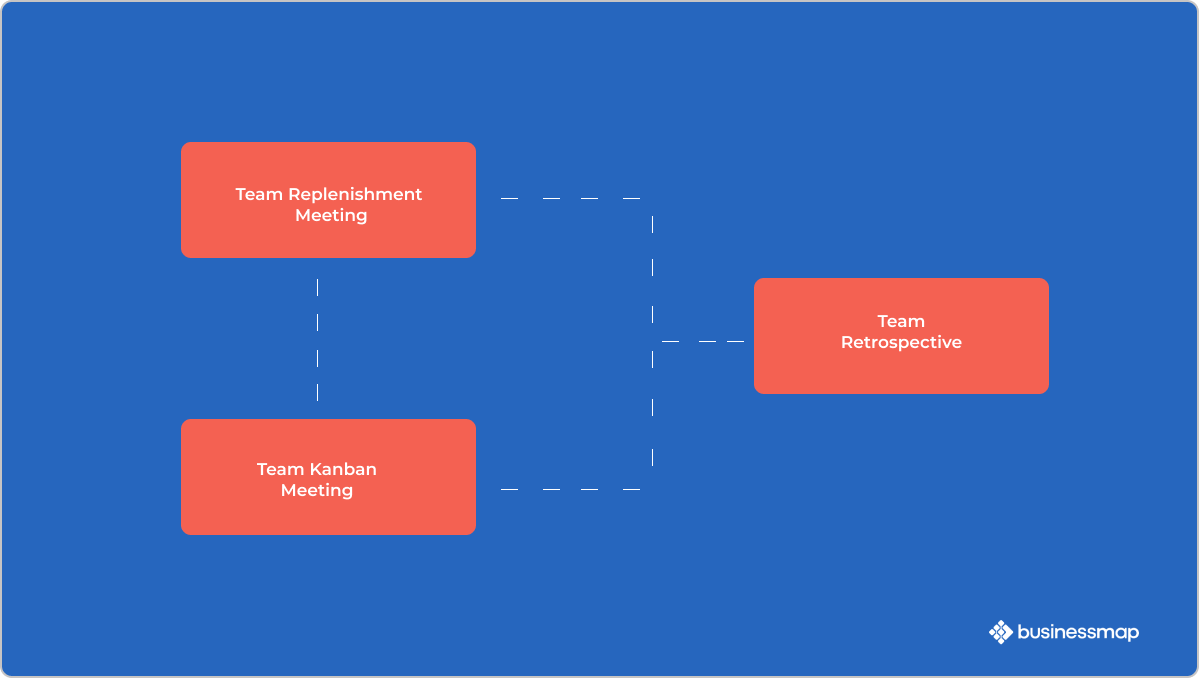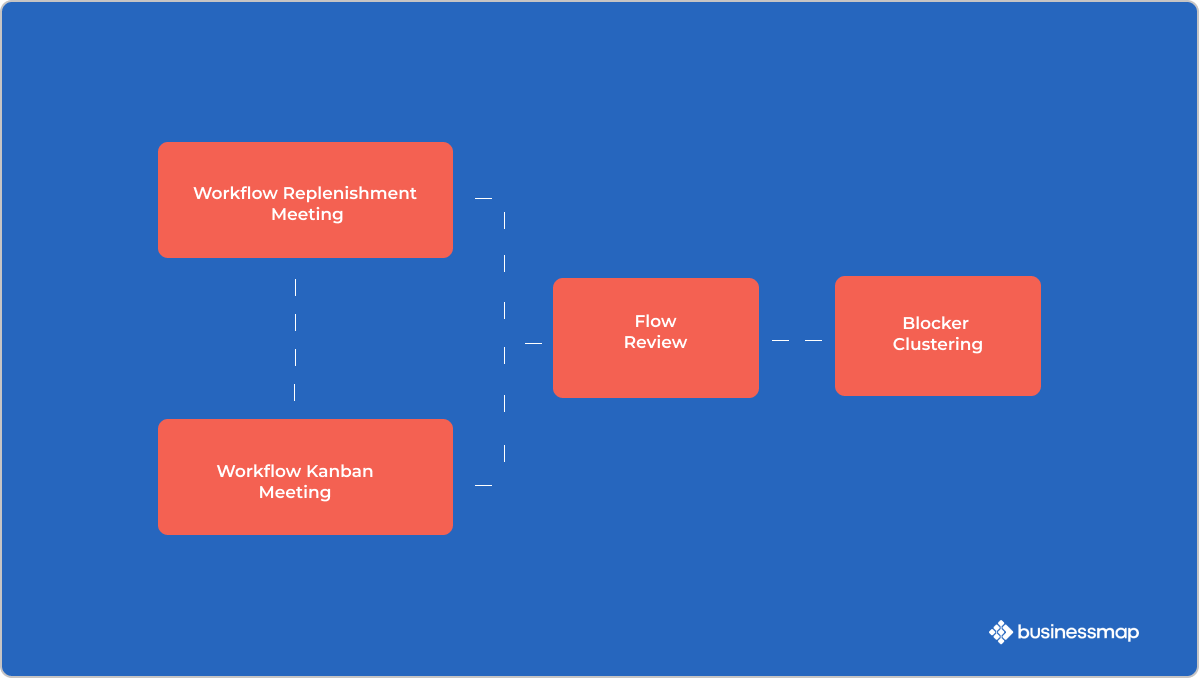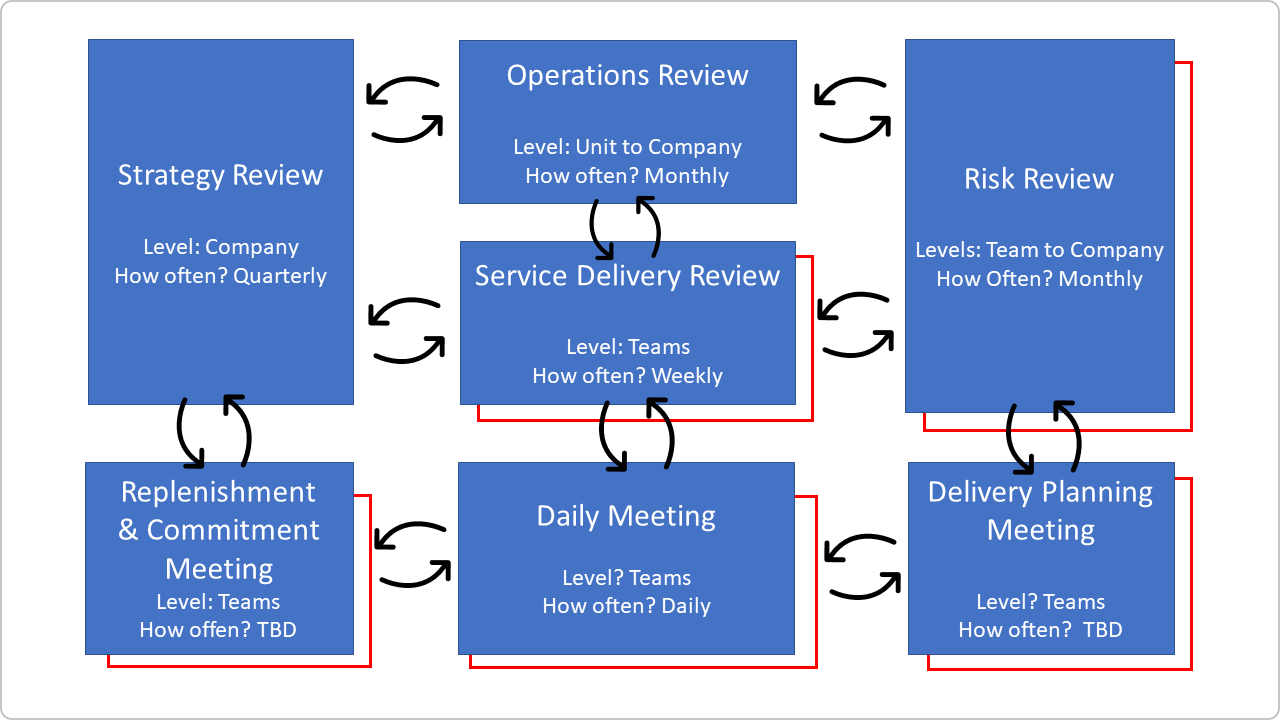How does it happen that all living beings, from a single-celled organism to a human body, know how to grow, adapt to an environment, and simply keep living? Even if each cell is a complex and relatively independent piece of machinery, synchronization at a higher level (tissues, organs) is achieved by receiving and processing external signals with senses and using internal biochemical feedback loops to assure alignment.
It’s not much different in the world of all sizes of organizations operating in complex environments. In order to perform well – individual employees, teams, and departments are in need of a well-aligned network of feedback loops.
Observing numerous teams and organizations that decided to follow the way of Kanban evolution, I see a repeating pattern – being unaware of or underestimating the importance of feedback loops outside of the team-level Kanban system. It significantly increases the risk that an efficient team benefiting from lower Muda and WIP-limit-driven focus will work in detachment from business priorities. In the best-case scenario, the team could become a local optimum. How to avoid it? Kanban Cadences could be the answer you’re looking for!
What Are Kanban Cadences?
Kanban Cadences are a suggested series or rather a network of meetings, fostering proper bi-directional communication happening at all necessary levels of your organization. Just like the system of biochemical feedback loops between all cells, tissues, and vital organs of your body.
I see a common misunderstanding that Kanban Cadences, proposed originally by David Anderson in 2015 as part of Enterprise Services Planning (ESP) practices, are applicable to big companies only. That’s not true. Kanban Cadences can significantly help to evolve towards continuous work focused on flow in organizations of any size.
Let’s see how that works using the two main classes of Kanban ceremonies.
What Are Team Level Cadences?

- Daily Meeting / Team Kanban Meeting – a daily team synchronization is also known as “walking the board”. Walking right to left, naturally. It’s a good moment to identify any new events at a level of the team like blockers. Swarm around them. Present new information generated during work. The Daily Kanban is also a moment to check if we respect WIP limits, and focus on delivering tasks in progress before pulling new ones.
- Replenishment & Commitment Meeting – depending on the context (granularity of tasks and speed of the team) its occurrence could range from daily to bi-weekly (an equivalent of Sprint Plannings). It’s focused on making sure the team has enough of the right tasks to do and can commit to delivering these tasks.
- Team Retrospective – a bi-weekly or monthly review focusing on how teams manage their work as well as identifying room for improvement.
What Are Service-Oriented Cadences?

- Service Delivery Review / Workflow Kanban Meeting – is focused on checking the entire service performance (which may consist of multiple collaborating teams). An example is when you have 2 separate upstream and downstream teams, responsible for the creation of a service. They can engage in a feedback loop to measure performance against commitments, customer-focused metrics, quality, lead time, classes of services, etc.
Note: There is another feedback loop called Flow Review which represents a sub-cadence to the Service Delivery meeting. Rather than looking at customer expectations, it is more focused on the internal capability of the team or teams working towards a service completion. Its main goal is to understand the process flow, analyze events such as why certain tasks take too long to be completed, uncover bottlenecks, and look for ways to alleviate them.
- Operations Review – is a meeting similar to the Service Delivery Review but it covers a bigger part of the organization (ex. department, multiple dependent teams) or even a whole small company. It’s focused on assuring global flow over local optimizations and being fit for your customers.
- Risk Review / Blocker Clustering – is an opportunity to discuss and agree on risk profiles related to certain tasks or changes and act accordingly – assigning a new class of service or proper scheduling for example. It’s applicable to all levels of the organization. The risk analysis meeting is also a good opportunity to draw attention to any process impediments (blockers) occurring on a team or a department level. As a result of using this blocker clustering technique, you’ll get insights on how to reduce the blockers of your workflow and the risk of project delays.
- Strategy Review – is the highest level meeting reviewing and adjusting the strategy based on information from your customers and markets. It’s an opportunity to answer if you are still doing the right things. It’s a moment to challenge yourselves about survivability and how fit for purpose your business and operational model are.
As a result of conducting such meetings, the whole organization can achieve proper alignment, learn and plan experiments to improve and excel in its performance.
Why So Many Meetings?
Don’t Panic! Your life with Kanban Cadences is about helping you feel more like at the end of Patrick Lencioni’s “Death by Meeting“, not the beginning. If you don’t know this book, it’s a good read for everyone struggling with inefficient business meetings but let’s get to the point. Think about Kanban Cadences as a proposal, a roadmap.
What’s crucial to understand and what makes it easier to introduce cadences, is to map them to the meetings already happening at your organization. No matter if your organization works with a framework proposing some meetings at a team level, like Scrum, some Agile scaling frameworks (SAFe, LeSS, etc.), or your own home-brewed way of communication, there’s a big chance you could re-use some of the existing meetings. In practice, relatively small changes in focus, discussed metrics, and relevant people present at the meeting, maybe enough to start with. Remember, evolution instead of a revolution.
Let me help you with some examples. If your teams switched from iterative to a continuous type of work, they probably still participate in some Planning or Review ceremonies. If Kanban is your new DNA, think about evolving these meetings into corresponding replenishment and flow review meetings.
A similar case may be applicable to organizations having more traditional project management structures. Existing meetings focused on risks are a great starter for Kanban-style Risk Reviews. What’s important is how you talk about these risks. Do you discuss risk profiles, urgency, correlated cost of delay, and the right classes of service?
Taking such an approach will save you from doubling or adding extra meetings, probably lower the resistance to change, and quickly bring value. Keeping old types of meetings surrounding your teams working with Kanban won’t help them flourish for sure.
One more thing. Some of the Kanban Cadences are focused on a single service or product team (Team Kanban Meeting, Commitment & Kanban Replenishment) while others (Operations Reviews or Flow Review Meetings) may bring more value when covering the work of many teams, streams, or even departments. When thinking about connecting meetings, keep in mind the interest of all participants, so you don’t step into a trap of too big audiences or too long meetings.
Why Meeting So Often?
Let’s recap how often Kanban ceremonies are normally held:
Team Level Cadences
- Team Kanban Meeting - daily
- Replenishment & Commitment Meeting - daily to bi-weekly
- Team Retrospective - bi-weekly or monthly
Service-Oriented Cadences
- Service Delivery Review - bi-weekly
- Operations Review - monthly
- Blocker Clustering - monthly
- Strategy Review - quarterly
Proposed cadences for each type of meeting are just a starting point, giving your organization guidance on what occurrences may make sense. I’m sure you understand that events causing a need for your strategy review do not happen as often as meetings when you’re supposed to feed your team with the next tasks ready for their commitment.
As the Kanban Method welcomes response to new information and proposes an evolutionary approach, it’s OK to start with a selected cadence, review it and adjust it.

On the other hand, if there’s really important new information coming from the market or a customer, it may be recommended to organize a meeting on demand. When nothing is on fire, the choice of regular meetings vs. on-demand ones is related to the “cost” of finding a timeslot in people’s calendars, or the challenge of working with distributed teams having a short overlap of working hours.
Who's in Charge?
Everyone. As the Kanban Method suggests, you want to encourage acts of leadership at all levels, so it’s everyone’s role to support the organization's evolution and improvements.
As much as it’s not important about job titles, it’s good to have the empowerment to at least invite the right people to these meetings. Over time, again evolutionary, your organization may want to assure there are people filling the roles of Service Delivery and Service Request Managers, but that’s a different story.
Start with what you do now and good luck with introducing Kanban Cadences!

Radoslaw Orszewski
Guest Author
Lean & Agile coach, practitioner and Kanban Coaching professional focusing on the Kanban method with over 12 years of experience in areas such as project & team leadership, optimizing business flow by including all technical and non-technical stakeholders and working with C-level management. Radoslaw has a passion for transforming complex organizations toward business agility.



